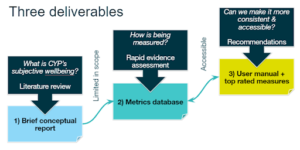Children and young people’s subjective wellbeing: how to measure it more consistently?
Wellbeing is ‘how we’re doing’ and how sustainable that is for the future. We are aiming to improve wellbeing for the whole population in the UK, including for children and young people – who are our future. This means we need to be looking regularly at how our young people are doing.
While we have very good national data on the wellbeing of adults, the national statistics on children and young people’s wellbeing in the UK, although robust and collected over a long period of time, is a small sample provided by Children’s Society and more recently the Big Ask survey from the Children’s Commissioner.
Today, in partnership with The Children’s Society, supported by The Health Foundation, we are publishing a comprehensive bank of measures of children’s wellbeing. This will help schools, colleges, universities and other settings measure the wellbeing of the children in their care.
As consensus around the importance of children’s wellbeing grows among researchers, the voluntary sector, and elected decision makers, more debate is arising around how to best capture their own voice and reports in a practical, robust and consistent way.
The most recent data on children’s subjective wellbeing shows that:
- 7% of 10 to 15 year olds (an estimated 306,000 children) in the UK are not happy with their lives.
- The majority of children aged 9—17 (80%) were happy or okay with their mental health. But 20% were unhappy, making it the top issue for children today.
- Girls were nearly twice as likely as boys to be unhappy with their mental health (25% vs 13%).
- Older children were also more likely to be unhappy (32% of 16—17‑year‑olds, compared to 9% of 9—11‑year‑olds). In fact, 40% of girls aged 16—17 were unhappy with their mental health.
We know from our work with LSE on the Origins of Happiness that:
- Emotional health in childhood affects later adult wellbeing.
- The difference schools make on emotional health can be seen in the data from primary school.
- Measurement, evaluations and programmes are possible and work.
We think wellbeing should be measured termly from Year 3 upwards (age 7/8) alongside educational attainment. Regularly collecting this data at a national level can help us understand better how children are and act effectively to improve lives.
We have collated the measures and tools being used in the UK to capture children and adolescents’ wellbeing from their own perspective (subjective wellbeing) so that schools, colleges, healthcare professionals, social care workers and others know that the measures they are using are safe, robust and consistent and the results are comparable and meaningful.
What did we do?

First, we reviewed the most influential literature in the area to outline the differences between objective and subjective measures of wellbeing, and to provide definitions for the various concepts and terminology that are being used to describe different aspects of subjective wellbeing. Read our conceptual report here.
Second, we used a Rapid Evidence Assessment methodology to collate all known and validated measures that have been used during the last decade to measure children’s subjective wellbeing in the UK. More than 90 measures have been compiled into a searchable bank with information about their validity, scoring and correct application.
Third, we produced a user manual to help navigate the bank of metrics and make informed decisions when choosing different measures, taking into account ethical and practical considerations.
Alongside this we are also publishing a review of the impact of interventions for under 18s using recommended national subjective wellbeing measures.
This set of materials is expected to allow for more standardised measurement practices and comparative analyses, thus enabling better understanding of what works to improve children and adolescents’ wellbeing, ultimately leading to their improved wellbeing.
Next Steps
We follow an open, iterative and practical approach and our products in this exciting area are evolving:
- The measures bank is currently available in a downloadable spreadsheet format and continues to be filled in with information extracted from the nearly 300 studies included in the REA.
- Once the bank of measures is finalised, we will add to the guidelines a set of 10 top-rated measures. We will also produce a selection of case studies to illustrate how different sectors may choose and implement different metrics from the bank depending on their purpose and target audience.
- School, healthcare and social care practitioners, who have never measured the wellbeing of the children in their setting can easily be overwhelmed by the amount of tools to choose. We are planning to interpret the user guide for use by a non-technical audience soon.
#BeeWell
These measures are used by an increasing number of settings and the #BeeWell project will be trialling them across Greater Manchester secondary schools over the next three years.
#BeeWell is a good example of measuring young peoples’ wellbeing at large scale, using validated measures. Its methodology – driven by young people and refined by a panel of expert academics – is a great platform towards achieving this broader objective.
David Gregson, Strategic Lead and Chair of the #BeeWell Advisory Group says:
“Nancy Hey and her team at the What Works Centre for Wellbeing have been hugely influential in the direction that we have taken with #BeeWell across Greater Manchester. The team has been involved every step of the way for the last two years, as we seek to move towards standardised assessment of wellbeing nationwide, and thereby make the wellbeing of young people everyone’s business.”
Measuring Children's Subjective Wellbeing resources
Explore further
